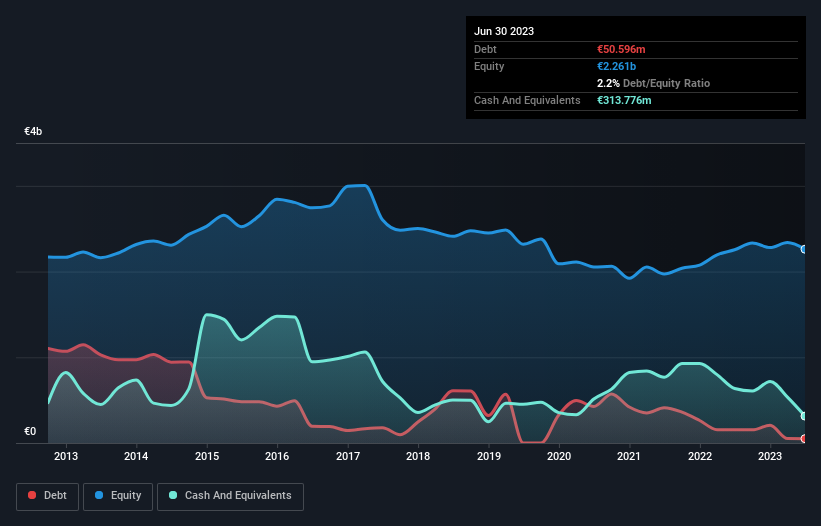Howard Marks put it nicely when he said that, rather than worrying about share price volatility, 'The possibility of permanent loss is the risk I worry about... and every practical investor I know worries about.' It's only natural to consider a company's balance sheet when you examine how risky it is, since debt is often involved when a business collapses. We can see that GEA Group Aktiengesellschaft (ETR:G1A) does use debt in its business. But should shareholders be worried about its use of debt?
What Risk Does Debt Bring?
Debt and other liabilities become risky for a business when it cannot easily fulfill those obligations, either with free cash flow or by raising capital at an attractive price. Ultimately, if the company can't fulfill its legal obligations to repay debt, shareholders could walk away with nothing. However, a more usual (but still expensive) situation is where a company must dilute shareholders at a cheap share price simply to get debt under control. Of course, debt can be an important tool in businesses, particularly capital heavy businesses. The first step when considering a company's debt levels is to consider its cash and debt together.
See our latest analysis for GEA Group
How Much Debt Does GEA Group Carry?
The image below, which you can click on for greater detail, shows that GEA Group had debt of €50.6m at the end of June 2023, a reduction from €154.3m over a year. But it also has €313.8m in cash to offset that, meaning it has €263.2m net cash.

How Healthy Is GEA Group's Balance Sheet?
We can see from the most recent balance sheet that GEA Group had liabilities of €2.40b falling due within a year, and liabilities of €1.05b due beyond that. On the other hand, it had cash of €313.8m and €1.23b worth of receivables due within a year. So it has liabilities totalling €1.91b more than its cash and near-term receivables, combined.
This deficit isn't so bad because GEA Group is worth €6.57b, and thus could probably raise enough capital to shore up its balance sheet, if the need arose. But we definitely want to keep our eyes open to indications that its debt is bringing too much risk. Despite its noteworthy liabilities, GEA Group boasts net cash, so it's fair to say it does not have a heavy debt load!
On top of that, GEA Group grew its EBIT by 72% over the last twelve months, and that growth will make it easier to handle its debt. The balance sheet is clearly the area to focus on when you are analysing debt. But ultimately the future profitability of the business will decide if GEA Group can strengthen its balance sheet over time. So if you want to see what the professionals think, you might find this free report on analyst profit forecasts to be interesting.
Finally, a business needs free cash flow to pay off debt; accounting profits just don't cut it. GEA Group may have net cash on the balance sheet, but it is still interesting to look at how well the business converts its earnings before interest and tax (EBIT) to free cash flow, because that will influence both its need for, and its capacity to manage debt. Over the last three years, GEA Group recorded free cash flow worth a fulsome 97% of its EBIT, which is stronger than we'd usually expect. That puts it in a very strong position to pay down debt.
Summing Up
Although GEA Group's balance sheet isn't particularly strong, due to the total liabilities, it is clearly positive to see that it has net cash of €263.2m. The cherry on top was that in converted 97% of that EBIT to free cash flow, bringing in €191m. So we don't think GEA Group's use of debt is risky. When analysing debt levels, the balance sheet is the obvious place to start. However, not all investment risk resides within the balance sheet - far from it. Case in point: We've spotted 1 warning sign for GEA Group you should be aware of.
If you're interested in investing in businesses that can grow profits without the burden of debt, then check out this free list of growing businesses that have net cash on the balance sheet.
New: Manage All Your Stock Portfolios in One Place
We've created the ultimate portfolio companion for stock investors, and it's free.
• Connect an unlimited number of Portfolios and see your total in one currency
• Be alerted to new Warning Signs or Risks via email or mobile
• Track the Fair Value of your stocks
Have feedback on this article? Concerned about the content? Get in touch with us directly. Alternatively, email editorial-team (at) simplywallst.com.
This article by Simply Wall St is general in nature. We provide commentary based on historical data and analyst forecasts only using an unbiased methodology and our articles are not intended to be financial advice. It does not constitute a recommendation to buy or sell any stock, and does not take account of your objectives, or your financial situation. We aim to bring you long-term focused analysis driven by fundamental data. Note that our analysis may not factor in the latest price-sensitive company announcements or qualitative material. Simply Wall St has no position in any stocks mentioned.
About XTRA:G1A
GEA Group
Produces and supplies systems and components to the food, beverage, and pharmaceutical industries worldwide.
Flawless balance sheet established dividend payer.
Similar Companies
Market Insights
Community Narratives



